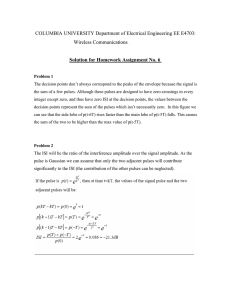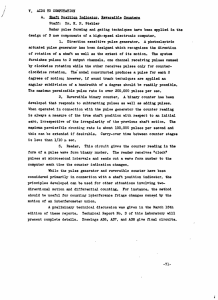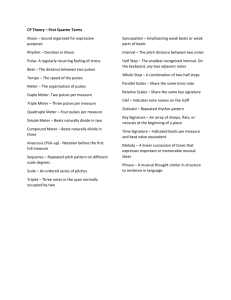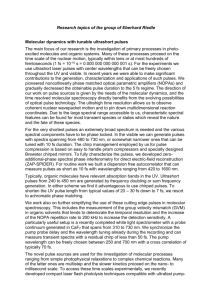Document 13461521
advertisement
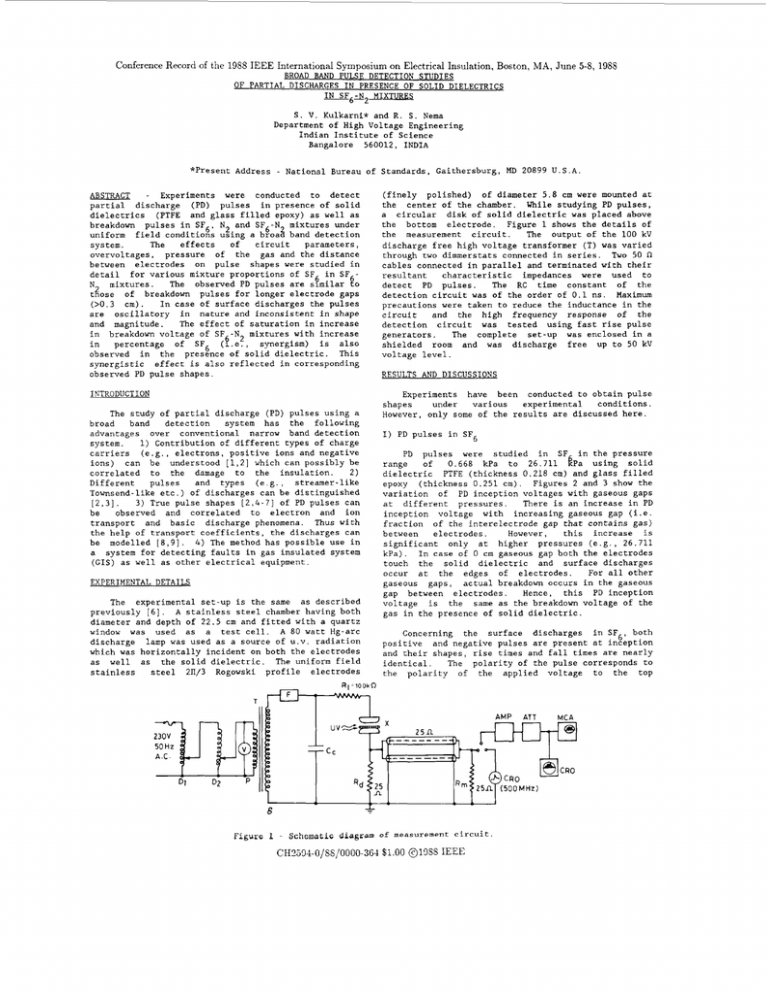
Conference Record of the 1988 IEEE International Symposium on Electrical Insulation,Boston, MA, June 5-8, 1988 BROAD BAND PULSE DETECTION STUDIES OF PARTIAL DISCHARGES IN PRESENCE OF SOLID DIELECTRICS IN SF6-N2 MIS . V. Kulkarni* and R. S . Nema Department of High Voltage Engineering Indian Institute of Science Bangalore 560012, INDIA *Present Address - National Bureau of Standards, Gaithersburg, MD 20899 U.S.A ABSTRACT - Experiments were conducted to detect partial discharge (PD) pulses in presence of solid dielectrics (PTFE and glass filled epoxy) as well as breakdown pulses in SF6, N and SF -N mixtures under uniform field conditions d i n g a b8oai band detection system. The effects of circuit parameters, overvoltages, pressure of the gas and the distance between electrodes on pulse shapes were studied in detail for various mixture proportions of SF6 fn SF N mixtures. The observed PD pulses are similar go d o s e of breakdown pulses for longer electrode gaps (>0.3 cm). In case of surface discharges the pulses are oscillatory in nature and inconsistent in shape and magnitude. The effect of saturation in increase in breakdown voltage of SF - N mixtures with increase in percentage of SF (6L.e2, synergism) is also observed in the pres8nce of solid dielectric. This synergistic effect is also reflected in corresponding observed PD pulse shapes. (finely polished) of diameter 5 . 8 cm were mounted at the center of the chamber. While studying PD pulses, a circular disk of solid dielectric was placed above the bottom electrode. Figure 1 shows the details of the measurement circuit. The output of the 100 kV discharge free high voltage transformer (T) was varied through two dimmerstats connected in series. Two 50 n cables connected in parallel and terminated with their resultant characteristic impedances were used to detect PD pulses. The RC time constant of the detection circuit was of the order of 0.1 ns. Maximum precautions were taken to reduce the inductance in the circuit and the high frequency response of the detection circuit was tested using fast rise pulse generators. The complete set-up was enclosed in a shielded room and was discharge free up to 50 kV voltage level. INTRODUCTION Experiments have been conducted to obtain pulse shapes under various experimental conditions. However, only some of the results are discussed here. The study of partial discharge (PD) pulses using a broad band detection system has the following advantages over conventional narrow band detection system. 1) Contribution of different types of charge carriers (e.g., electrons, positive ions and negative ions) can be understood [ 1 , 2 ] which can possibly be correlated to the damage to the insulation. 2) Different pulses and types (e.g., streamer-like Townsend-like etc.) of discharges can be distinguished [2,3]. 3 ) True pulse shapes [ 2 , 4 - 7 1 of PD pulses can be observed and correlated to electron and ion transport and basic discharge phenomena. Thus with the help of transport coefficients, the discharges can be modelled [ 8 , 9 ] . 4 ) The method has possible use in a system for detecting faults in gas insulated system (GIS) as well as other electrical equipment. EXPERIMENTAL DETAILS The experimental set-up is the same as described previously [6]. A stainless steel chamber having both diameter and depth of 2 2 . 5 cm and fitted with a quartz window was used as a test cell. A 80 watt Hg-arc discharge lamp was used as a source of U.V. radiation which was horizontally incident on both the electrodes as well as the solid dielectric. The uniform field stainless steel 2II3/3 Rogowski profile electrodes - 230V 5 0 HZ A.C. F II c RESULTS AND DISCUSSIONS I) PD pulses in SF 6 PD pulses were studied in SF in the pressure range of 0 , 6 6 8 kPa to 2 6 . 7 1 1 f;Pa using solid dielectric PTFE (thickness 0 . 2 1 8 cm) and glass filled epoxy (thickness 0 . 2 5 1 cm). Figures 2 and 3 show the variation of PD inception voltages with gaseous gaps at different pressures. There is an increase in PD inception voltage with increasing gaseous gap (i.e. fraction of the interelectrode gap that contains gas) between electrodes. However, this increase is significant only at higher pressures (e.g.,2 6 . 7 1 1 kPa). In case of 0 cm gaseous gap both the electrodes touch the solid dielectric and surface discharges occur at the edges of electrodes. For all other gaseous gaps, actual breakdown occurs in the gaseous gap between electrodes. Hence, this PD inception voltage is the same as the breakdown voltage of the gas in the presence of solid dielectric. Concerning the surface discharges in SF6, both positive and negative pulses are present at inception and their shapes, rise times and fall times are nearly identical. The polarity of the pulse corresponds to the polarity of the applied voltage to the top I AMP n, -, "L I 6 Figure 1 - + - Schematic diagram of measurement - - circuit CH2594-O/SS/0000-36d$1.00 @19SS IEEE ATT MCA electrode connected to the high voltage side. At 0.668 kPa, Townsend-like pulses are observed while at higher pressures streamer-like pulses are observed. The streamer-like pulses exhibit large electronic component corresponding to the first peak which is followed by an oscillatory decay. Concerning the rise time, fall time and magnitude of PD pulses it is observed that the general behavior is similar to that of the breakdown pulses between two metallic electrodes. The rise time of the pulse corresponds to the development of electron avalanche and hence the area corresponding to the rise time of the pulse represents the electronic charge in the avalanche head. The fall time corresponds to the current induced due to the movement of the uositive I> 32 008- sF6 / 28 / I / / / / / d 2 6 . 7 1 1 kPa " I.o 0.5 0 G-eous - Figure 2 I .5 gap ,cm Measured PD inception voltages in SF6-PTFE composite dielectric. - / 26.711hPw - / / > 0 01 '' 20- 5 f - g 6 - / / / / / / 16- G - o 12- / / ,, / 8 - Figure 3 // - ,, / / / / A ./ 13355, 0' / ,' , , /' ' It is also observed at inception that, in the presence of the solid dielectric, both positive and negative pulses are present for the different polarities associated with applied alternating voltage. However, the magnitudes of negative pulses are larger than those of positive pulses. This difference in magnitudes of different polarities of pulses is not observed in case of breakdown pulses between two metallic electrodes. It can be expected that the photoelectron production is inhibited in cases where the dielectric covered electrode becomes the cathode so that the presence of U.V. radiation becomes ineffective. The positive pulse development then depends upon the availability of electrons near the high voltage electrode. When the uncovered electrode is negative, photoelectric action is more effective. Also, any charges present on the solid dielectric that modify the field in the gap may also depend on the polarity of the applied voltage. Hence, the mechanisms of PD pulse formation can be expected to differ for different polarities of applied voltage with corrsponding differences in rise times, fall times and magnitudes of the detected pulses. Also the difference in the secondary ionization coefficients for the metallic and dielectric surfaces may be a factor in influencing the discharge developement for different polarities. In order to study PD pulses under overvoltage conditions, the applied voltage was increased to twice the inception voltage at 26.711 kPa of SF with 0.1 cm 6 It is to 0.6 cm gaseous gaps between electrodes. observed that with the increase in the degree of overvoltage, the development of negative pulses is suppressed and their magnitudes decrease with an increase in the degree of overvoltage. However, the magnitudes of positive pulses continue to increase with increasing overvoltage. A decrease in fall times of positive pulses with overvoltage is also observed in case of PD pulses indicating the increase in the drift velocity of charge carriers. However, the fall times of negative pulses are not affected significantly indicating their suppression to further development with increase in the degree of overvoltage. Electrodas -uniform field &S- sF6 Epow thickmi-0.1512 cm 24 By comparing the rise and fall times of PD and breakdown pulses under similar conditions, it is usually, but not always, observed that the rise and fall times of PD pulses increase and the magnitudes of the pulses decrease with the introduction of a solid dielectric. The electronic component corresponding to the rise time of PD pulse has a relatively high magnitude and is short in duration. This behaviour is similar to that observed for breakdown pulses. Although breakdown pulses in SF6 always exhibit a tail of relatively low magnitude and long duration, this is not always seen for PD pulses in presence of solid dielectric. This may be the consequence of ion recombination processes on the surface of solid dielectric. / PTFE thickness-0218 cm 24 ions, negative ions and sometimes, detached electrons in case of SF6. -i. / 0 /- 11) PD pulses in SF6-N2 mixtures Measured PD inception voltages in SF -Epoxy composite dielectric. 6 365 The PD pulses were studied in mixtures of SF and N2 in the presence of PTFE dielectric at different 6 pressures and gap spacings. Figures 4, 5 and 6 show PD inception voltages for various percentages of SF 6 at 0.0 cm, 0.6 cm and 1.5 cm gaseous gaps between electrodes. As noted previously, 0.0 cm gaseous gap corresponds to the behavior of surface discharges (Fig. 4), while 0.6 cm and 1.5 cm behavior corresponds to the breakdown of the gaseous gap. It can be seen that although the PD inception voltage is higher in pure SF compared to that in pure N , the increase in PD incegtion voltage is not direct3y proportional to the SF content in the mixture. Thus the synergistic effect 'observed for breakdown voltages in mixtures with SF is also observed in the case of PD inception voltages6in the presence of a solid dielectric. pulses in SF are greater than those of N2 under similar condifions. The reason for this behavior is no doubt related to the electronegative nature of SF6. Figure 7 shows the PD pulses on PTFE dielectric at 26.711 kPa for different gaseous gap spacings. The fall time of negative PD pulse in N is longer than that of the negative pulse in SF,' under similar conditions. This suggests the less ionic contribution for PD pulses in SF6 possibly due to prominent recombination processes on the surface of the dielectric. The shapes of PD pulses do not show any significant change with the variation of SF6 concentration. The pulse shape is nearly the same from 100% SF6 to 25% SF6 in the mixture. Therefore, it can be said that the synergistic effect observed for the breakdown voltages of mixtures is also seen in case of PD pulses in mixtures. Concerning the surface discharges in SF6-N2 mixtures, both positive and negative pulses are observed at inception. In most cases the fall time is negligible for PD pulses in SF6, while the PD pulse tails or fall times tend to increase with increasing nitrogen content. It is also observed that the variation in fall times is highest in the range of 0% SF to 25% SF and is insignificant for more than 25% 6 SF:. This behavior is also observed in case of rise time, pulse magnitude and even in the case of the oscillations observed on the fall off or decay of the surface discharge pulses. At 1 3 . 3 6 kPa, positive and negative oscillatory pulses of similar shapes and magnitudes exist in SF6 while these oscillations are absent in case of N2 ' Concerning the observed that the SF are lower than N2t whereas the exactly opposite, PD pulses in SF -N mixtures, it magnitudes of pgsizive PD pulses those for the positive PD pulses behavior of negative PD pulses i.e., the magnitudes of negative 1 ' 32 1 ' GaS-SFg- 28 - is in in is PD 1 ' 1 ' 1 ' 1 Electrodes- uniform field Ni ,d P T F E Thickness-0 218cm Gaseous gap - I 5cm ~'26 711 k h /' d ' /' / 24 d >n -11 20- /' 8 -- -A- -- - -6 ---I 6.678 - -3339 0 Figure 4 - Measured PD inception voltages in SF6-N2PTFE composite dielectric at different percentages of SF6 in case of surface discharges ( 0 . 0 cm gaseous gap). I 0 I 20 + - - - 1- - - - ,01668 I I I I I A 40 60 percentage of S F 6 Figure 6 Electrodes uniform field - - 80 I00 ,% Measured PD inception voltages in SF -N PTFE composite dielectric at diffgreit percentages of SF6 for a 1.5 cm gaseous gap. P T F E thickness -0.218Cm 2. CONCLUSIONS 12 Partial discharge and breakdown pulse shapes were studied under uniform field conditions in SF -N mixtures using a broad band detection system. 6Tht solid dielectrics studied are glass filled epoxy, and PTFE. The synergistic effect in breakdown voltages of SF -N mixture with increase in percentage of SF 6 is a180 'observed in the presence of solid dielectric and is reflected in corresponding PD pulse shapes. 0 e 0 ACKNOWLEDGEMENTS The authors are thankful to the authorities of the Indian Institute of Science for the permission to publish this work and also to Dr. R. J . Van Brunt and Dr. Jim Olthoff of the National Bureau of Standards for their keen interest and assistance in the preparation of the manuscript. percentage of s F 6 , X Figure 5 - Measured PD inception voltages in SF6-N2PTFE composite dielectric at different percentages of SF6 for a 0.6 cm gaseous gap. 366 100% SF6, 50"s 0.0166. Ocm 75% SF^. IOOns 0.016A % 100% SF6 , O m 75 Sons 100ns 100% SOOns 0 016A SF^ 500ns Osm 20"s 0 . W 6 A SF6 Ocm 25% , 5FS,0cn 0.OISA ZOns 0.0081 0.6cm 0.04A Ocm 0 % SF6. -# loons 0.016A 0% SF6 0 . 6 loom 0.16A 0.6cm 0.16A 100 % SF6 SF6. 25% Ocm 3 7 5 X S F 0 0.Sam 5OOns 0.011 .- 2 5 % SFa Sons 0.6am 0.041 0 % SF6, 2Wns 0% 5.111 12 0.65111 0.001 SF6 2 0 0 n. I.5cm 0.16A 24 Figure 7 - Pd pulses in SF6-N2-PTFE combination at 26.71 kPa at different percentages of SF6 and at different gaseous gaps. (Scale divisions are given by indicated times and currents). REFERENCES Reference to Electronegative Gases and Their Mixtures," Ph.D. Thesis, Indian Institute of Science, Bangalore, India (1987). 1. J. C. Devins, "The Physics of Partial Discharges in Solid Dielectrics," IEEE Trans. on Elec. Insul. Vol. EI-19, NO. 5 , pp. 475-495 (1984). 2. B. Luczynski, "Transients vdladhingstorlobihomogent felt atgramsent at metalelk-trodem," Ph. D. Thesis, Technical University of Denmark, (1972). S. V. Kulkarni and R. S . Nema, "Broad Band Pulse Detection Studies of Corona and Breakdown in Air, N , 0 , CO , SE6 and SF -N Mixtures," Int. Symp. 0; Gasgous 8ielectrics. knozville, Tennessee, USA, pp. 637-642 (1987). 3. S. Nagata* H. Nakayama and y. Inuishi, "Overvoltage Dependence of Partial Discharge in Composite Dielectrics," Elec. Eng. in Japan, Vol. 92, NO. 6, pp. 35-45 (1972). 7. C. Mayoux, "Analogy Between Corona and Partial Discharges Phenomena in Organic Insulating Materials," Proc. of 2nd Int. Conf. on Gas Discharges, pp. 242-244 (1972). 4. 1. Degn, Discharges in Dielectrics," Ph.D. Thesis, Technical University of Denmark, Lyngby (1971). 8. R. Morrow, "Theory of Negative Corona in Oxygen," Phys. Rev. A , Vol. 32, pp. 1799-1809 (1985). 5. V. Kulkarni, "Prebreakdown and Breakdown Phenomena in Composite Dielectrics with Special 6. 9, S. 367 R. S . Sigmond, "Corona Discharges" in "Electrical Breakdown of Gases", Eds. Meek and Craggs, Wiley, New York, Chapt. 5 , pp. 319-384 (1978).
